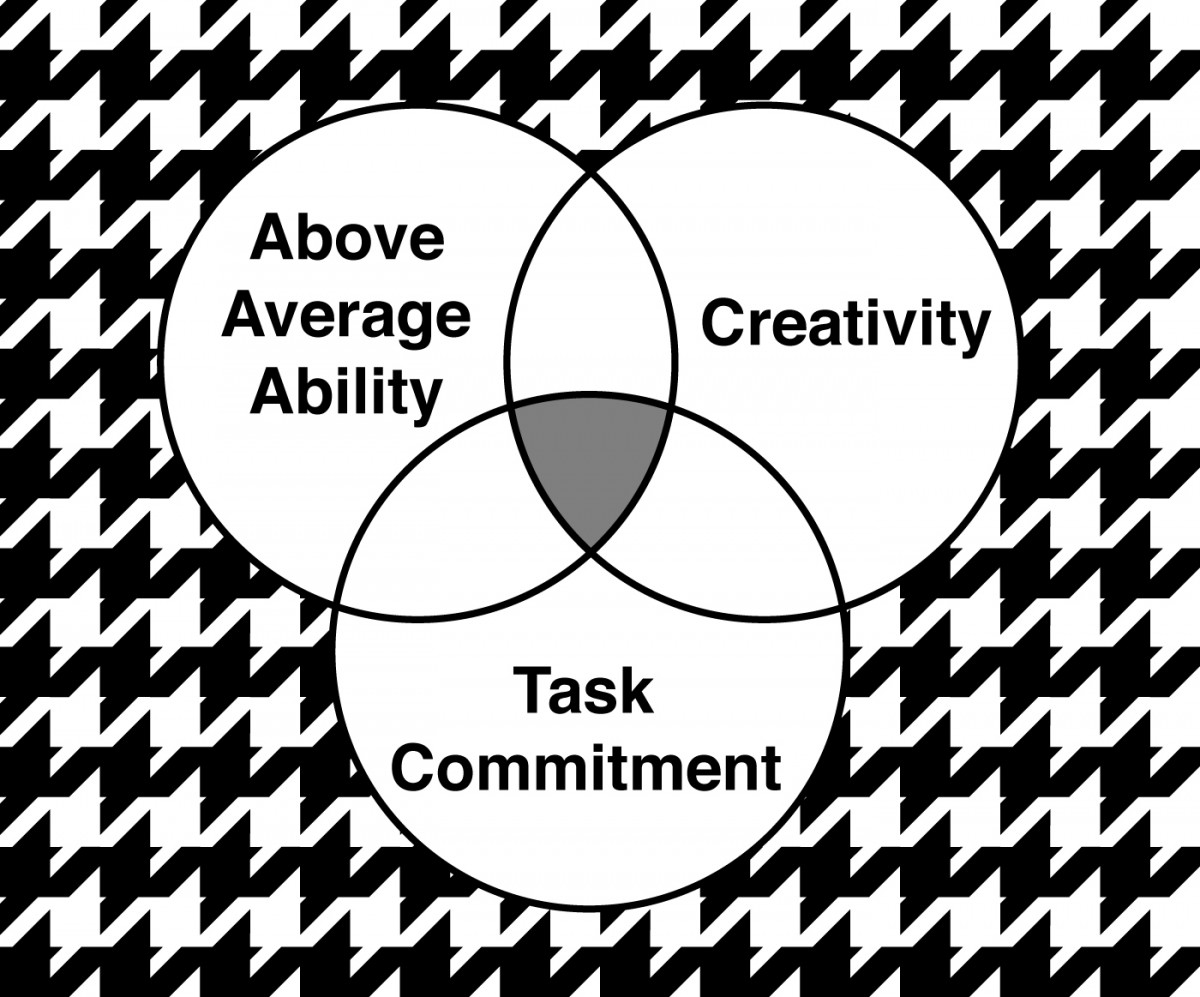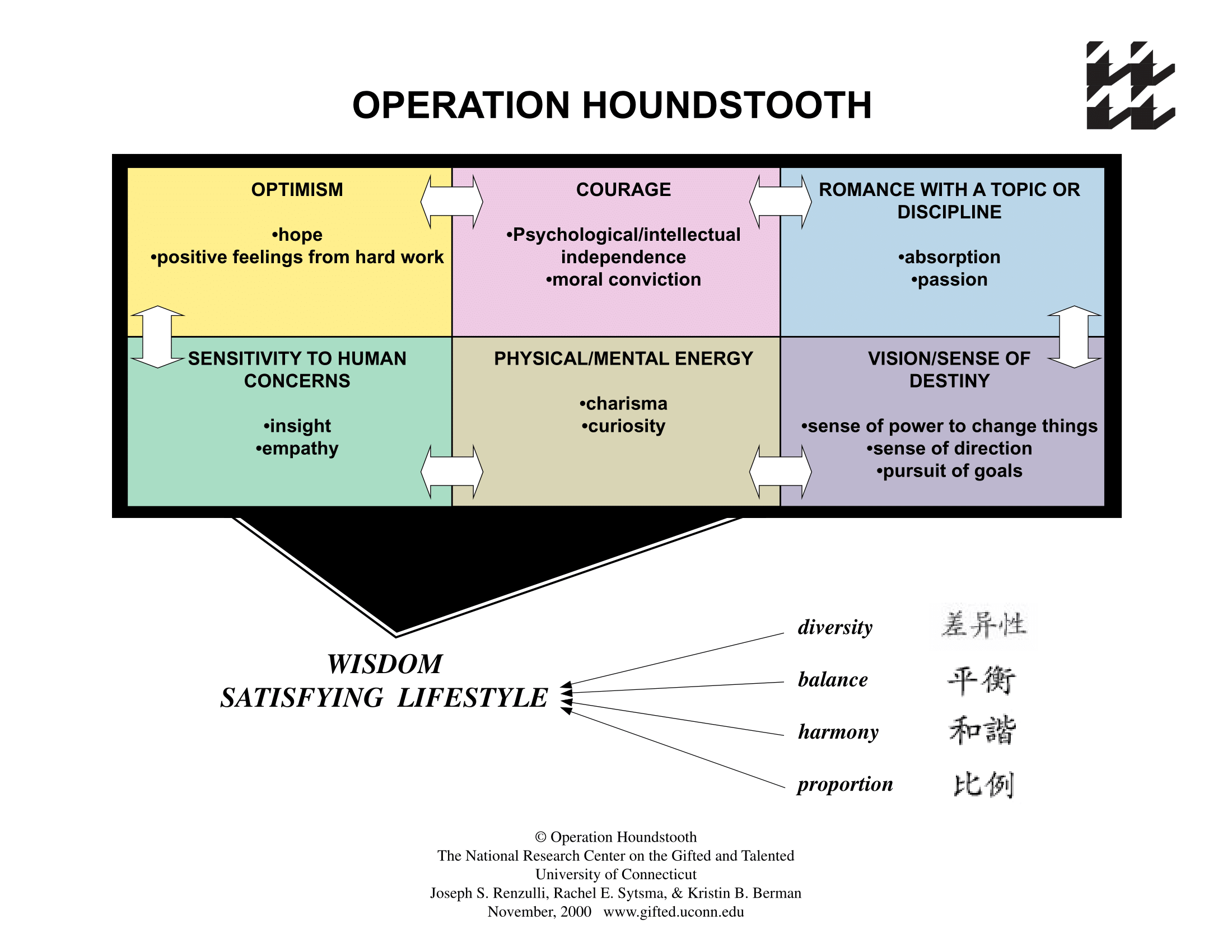In October 2016, the Honors Board of Associate Directors approved a new theoretical framework for the UConn Honors Program. This framework, based on the work of UConn Board of Trustees Distinguished Professor Joseph Renzulli, informs our goals, practices, and assessment.
There are three foundational theories in this framework.
Three Ring Conception of Giftedness

Renzulli[1] defines gifted behaviors as creative productivity resulting from an interaction of above average ability, creativity, and task commitment applied toward any “potentially valuable area of human performance.” Each of those three “rings” must exist, and they must intersect at some point, but they do not need to be the same size.
This creative productivity is the core goal of UConn Honors. Honors Scholars should create something that is unique to them, beyond what is expected for UConn undergraduates, and share that creation with an authentic audience.
Admission into UConn Honors is based on a student’s potential to align these three rings. Renzulli’s work supports a broad net for identification;[2] approximately 10% of UConn undergraduates are enrolled in Honors.
Enrichment Triad Model
UConn Honors programming (both curricular and co-curricular) should be oriented toward either increasing the size of the three rings or helping a student identify the area in which they want to focus. The Enrichment Triad Model[3] describes three different ways in which programming may promote creative productivity:
- Type 1 Enrichment
-
Activities designed to help students see the breadth of possibilities so that they can find the area(s) or problem(s) that excite them. This type of enrichment is about finding the place where a student’s rings will intersect.
- Type 2 Enrichment
-
Activities that build skills needed for creative productivity. These might be general skills related to one of the three rings, or they might be very specific to a student’s work. This type of enrichment is about increasing the size of one or more of the three rings.
- Type 3 Enrichment
-
These activities provide direct support for creative productivity. They help a student align their three rings, create something new, and disseminate it beyond the classroom.
This umbrella of “enrichment” includes Honors classes–both inside and outside the major–and the entire spectrum of co-curricular activities.
Operation Houndstooth
 Renzulli’s latest work gives direction to creative productivity. It addresses the question of what influences someone to make a difference and positively affect the world around them. Operation Houndstooth[4] explicitly connects social good, creative productivity, and life satisfaction or happiness. There are six factors in this model:
Renzulli’s latest work gives direction to creative productivity. It addresses the question of what influences someone to make a difference and positively affect the world around them. Operation Houndstooth[4] explicitly connects social good, creative productivity, and life satisfaction or happiness. There are six factors in this model:
- Optimism, which is linked to overall mental health
- Courage, which is linked to confidence, competence and self-efficacy, autonomy, and risk-taking
- Romance with a topic or discipline
- Sensitivity to human concerns
- Energy
- Vision or sense of destiny, as long as that vision goes beyond merely self-determination.
The “houndstooth” refers to the background of the Three Rings Conception above. These co-cognitive factors underlie the three rings. They may affect whether the rings ever align as well as the types of problems students choose to solve.
Operation Houndstooth fleshes out the “whole person” perspective of our program. Creative productivity helps change the world, but it also helps our students be happier and more satisfied with their lives. Rather than (or in addition to) serving as Type 1, Type 2, or Type 3 enrichment, Honors curricular and co-curricular activities may address one or more of the Houndstooth factors as a way of promoting creative productivity.
Putting It Together
This framework provides a firm foundation to tell students that a UConn Honors education should prepare them to make unique contributions to their chosen fields and to the world. It supports the Honors Program vision:
Honors students will value knowledge at the broadest level while achieving distinction in their fields of study. They will be prepared for leadership in their chosen professions and will serve their communities as responsible local and global citizens.
1. ^ Renzulli, Joseph S. “What Makes Giftedness? Reexamining a Definition.” Phi Delta Kappan 60 (1978): 180-84, 261.
2. ^ Renzulli, Joseph S., and Sally M. Reis. The Schoolwide Enrichment Model: A How-to Guide for Educational Excellence. 2nd ed. Mansfield Center, CT: Creative Learning Press, 1997.
3. ^ Renzulli, Joseph S. “The Enrichment Triad Model: A Guide for Developing Defensible Programs for the Gifted and Talented.” Gifted Child Quarterly 20, no. 3 (1976): 303-26.
4. ^ Renzulli, Joseph S. “Expanding the Conception of Giftedness to Include Co-Cognitive Traits and to Promote Social Capital.” The Phi Delta Kappan 84, no. 1 (2002): 33-58.